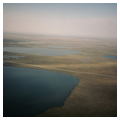The terminus of the Trans-Alaska Pipeline is in Valdez, where the oil is loaded onto tankers at the Marine Terminal. Architecturally, the pipeline is of most interest as an illustration of construction techniques employed in the Alaskan terrain. The 800-mile pipeline runs above ground where there is permafrost—approximately half of its length—and underground where possible. Underground, the pipeline is laid on a gravel bedding 8 feet to 16 feet deep, and covered with gravel padding and dirt fill. Above ground, the insulated pipeline rests on Teflon-coated shoes on crossbeams that allow the pipe to move sideways 12 feet to accommodate natural expansion and contraction or movement due to earthquakes. The crossbeam supports are arranged in a zigzag pattern that converts longitudinal expansion into sideways movement. In places where the permafrost is just below the freezing point, and therefore most fragile, the supports are fitted with heat pipes containing a refrigerant. Heat is conducted up and into finlike radiators, which dispel the heat into the air.
In its 800-mile length, the pipeline rises over 5,000 feet, dropping again to sea level, and crosses eight hundred rivers and streams. Ten pump stations assist the oil in its journey from the North Slope. The pipeline is paralleled by the Dalton Highway from Prudhoe Bay to Livengood, the Elliott Highway from Livengood to Fairbanks, and the Richardson Highway from Fairbanks to Valdez, and is visible at many points along the way. Whether reviled as a blight on the landscape, or hailed as a Christo-like Running Fence that defines the landscape in human terms, the oil pipeline is a visual image that is increasingly identified with Alaska.















